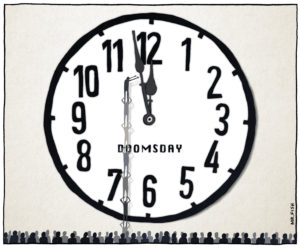Aircon Turns Up the City Heat
As cities get hotter in the changing climate, the increased use of air conditioners is worsening the problem -- especially at night, U.S. researchers say.
By Tim Radford, Climate News NetworkThis piece first appeared at Climate News Network.
LONDON — Researchers in the US have identified a way in which city-dwellers are inadvertently stoking up the heat of the night — by installing air conditioners.
Because the cities are getting hotter as the climate changes, residents are increasingly investing in aircon systems — which discharge heat from offices and apartment blocks straight into the city air. And the vicious circle effect is that cities get still warmer, making air conditioning all the more attractive to residents.
According to scientists at Arizona State University, the air conditioning system is now having a measurable effect. During the days, the systems emit waste heat, but because the days are hot anyway, the difference is negligible. At night, heat from air conditioning systems now raises some urban temperatures by more than 1°C, they report in the Journal of Geophysical Research Atmospheres.
The team focused on the role of air conditioning systems in the metropolitan area of the city of Phoenix, which is in the Sonora desert in Arizona, and conditions in the summertime are harsh there anyway.
But, worldwide, normally warm countries are experiencing increasing extremes of heat, and conditions in cities have on occasion become lethal.
To cap this, cities are inevitably hotspots — and it’s not just because of global warming. The concentration of traffic, commuter systems, street and indoor lighting, central heating, light industry, tarmac, tiles, bricks, building activity and millions of people can raise temperatures as much as 5°C above the surrounding countryside.
At present, 87% of US households have air conditioning, and the US — which is not one of the warmer nations — uses more electricity to keep cool than all the other countries of the world combined. To keep the people of Phoenix cool during periods of extreme heat, air conditioning systems can consume more than half of total electricity needs, which puts a strain on power grids.
The Arizona scientists simulated a 10-day period of unusually hot weather between 10 July and 19 July, 2009, and used computer models and detailed readings from weather records to analyse the effect of air conditioning systems on local temperatures. Even though the biggest demand for air conditioning was in the daytime, they found the biggest difference was always at night.
“Our work demonstrates one Celsius degree local heating of urban atmospheres in hot and dry cities due to air conditioning use at night time,” said Francisco Salamanca, the report’s lead author. “This increase in outside air temperature in turn results in additional demands for air conditioning.
“Sustainable development and optimisation of electricity consumption would require turning wasted heat from air conditioning into useful energy, which can be used inside houses for various purposes — including, for example, water heaters.”
Such actions would reduce local air temperatures: in Phoenix alone, they could directly save more than 1200 Megawatt hours of electricity per day.
In 2012, the US experienced a set of record-breaking temperatures, and the US Department of Energy has warned that days of extreme heat are expected to become more frequent and more intense because of climate change.
But this seems already to be a pattern worldwide, according to recent analyses of climate patterns. And the demand for air conditioning is expected to accelerate in India, China and other emerging economies.
Your support matters…Independent journalism is under threat and overshadowed by heavily funded mainstream media.
You can help level the playing field. Become a member.
Your tax-deductible contribution keeps us digging beneath the headlines to give you thought-provoking, investigative reporting and analysis that unearths what's really happening- without compromise.
Give today to support our courageous, independent journalists.






You need to be a supporter to comment.
There are currently no responses to this article.
Be the first to respond.